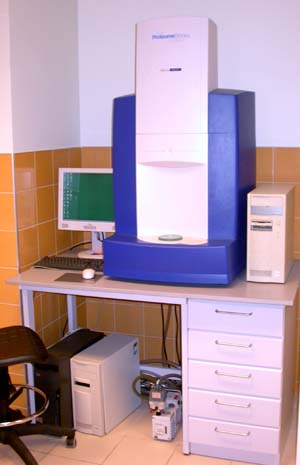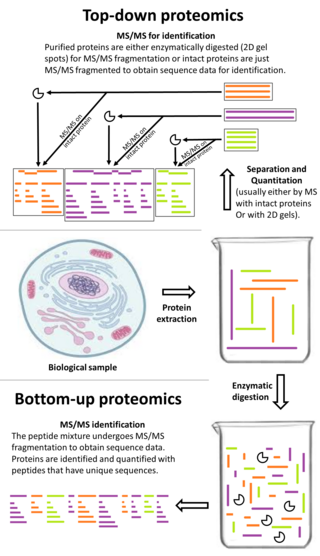Related Research Articles

Tandem mass spectrometry, also known as MS/MS or MS2, is a technique in instrumental analysis where two or more stages of analysis using one or more mass analyzer are performed with an additional reaction step in between these analyses to increase their abilities to analyse chemical samples. A common use of tandem MS is the analysis of biomolecules, such as proteins and peptides.

Cystic fibrosis transmembrane conductance regulator (CFTR) is a membrane protein and anion channel in vertebrates that is encoded by the CFTR gene.

Peptide mass fingerprinting (PMF), also known as protein fingerprinting, is an analytical technique for protein identification in which the unknown protein of interest is first cleaved into smaller peptides, whose absolute masses can be accurately measured with a mass spectrometer such as MALDI-TOF or ESI-TOF. The method was developed in 1993 by several groups independently. The peptide masses are compared to either a database containing known protein sequences or even the genome. This is achieved by using computer programs that translate the known genome of the organism into proteins, then theoretically cut the proteins into peptides, and calculate the absolute masses of the peptides from each protein. They then compare the masses of the peptides of the unknown protein to the theoretical peptide masses of each protein encoded in the genome. The results are statistically analyzed to find the best match.

In mass spectrometry, matrix-assisted laser desorption/ionization (MALDI) is an ionization technique that uses a laser energy-absorbing matrix to create ions from large molecules with minimal fragmentation. It has been applied to the analysis of biomolecules and various organic molecules, which tend to be fragile and fragment when ionized by more conventional ionization methods. It is similar in character to electrospray ionization (ESI) in that both techniques are relatively soft ways of obtaining ions of large molecules in the gas phase, though MALDI typically produces far fewer multi-charged ions.

Electron-capture dissociation (ECD) is a method of fragmenting gas-phase ions for structure elucidation of peptides and proteins in tandem mass spectrometry. It is one of the most widely used techniques for activation and dissociation of mass selected precursor ion in MS/MS. It involves the direct introduction of low-energy electrons to trapped gas-phase ions.
Sequest is a tandem mass spectrometry data analysis program used for protein identification. Sequest identifies collections of tandem mass spectra to peptide sequences that have been generated from databases of protein sequences.
PEAKS is a proteomics software program for tandem mass spectrometry designed for peptide sequencing, protein identification and quantification.

Electron-transfer dissociation (ETD) is a method of fragmenting multiply-charged gaseous macromolecules in a mass spectrometer between the stages of tandem mass spectrometry (MS/MS). Similar to electron-capture dissociation, ETD induces fragmentation of large, multiply-charged cations by transferring electrons to them. ETD is used extensively with polymers and biological molecules such as proteins and peptides for sequence analysis. Transferring an electron causes peptide backbone cleavage into c- and z-ions while leaving labile post translational modifications (PTM) intact. The technique only works well for higher charge state peptide or polymer ions (z>2). However, relative to collision-induced dissociation (CID), ETD is advantageous for the fragmentation of longer peptides or even entire proteins. This makes the technique important for top-down proteomics. The method was developed by Hunt and coworkers at the University of Virginia.

Protein mass spectrometry refers to the application of mass spectrometry to the study of proteins. Mass spectrometry is an important method for the accurate mass determination and characterization of proteins, and a variety of methods and instrumentations have been developed for its many uses. Its applications include the identification of proteins and their post-translational modifications, the elucidation of protein complexes, their subunits and functional interactions, as well as the global measurement of proteins in proteomics. It can also be used to localize proteins to the various organelles, and determine the interactions between different proteins as well as with membrane lipids.
Shotgun proteomics refers to the use of bottom-up proteomics techniques in identifying proteins in complex mixtures using a combination of high performance liquid chromatography combined with mass spectrometry. The name is derived from shotgun sequencing of DNA which is itself named after the rapidly expanding, quasi-random firing pattern of a shotgun. The most common method of shotgun proteomics starts with the proteins in the mixture being digested and the resulting peptides are separated by liquid chromatography. Tandem mass spectrometry is then used to identify the peptides.

Bottom-up proteomics is a common method to identify proteins and characterize their amino acid sequences and post-translational modifications by proteolytic digestion of proteins prior to analysis by mass spectrometry. The major alternative workflow used in proteomics is called top-down proteomics where intact proteins are purified prior to digestion and/or fragmentation either within the mass spectrometer or by 2D electrophoresis. Essentially, bottom-up proteomics is a relatively simple and reliable means of determining the protein make-up of a given sample of cells, tissues, etc.

Golgi-associated PDZ and coiled-coil motif-containing protein is a protein that in humans is encoded by the GOPC gene.
In bio-informatics, a peptide-mass fingerprint or peptide-mass map is a mass spectrum of a mixture of peptides that comes from a digested protein being analyzed. The mass spectrum serves as a fingerprint in the sense that it is a pattern that can serve to identify the protein. The method for forming a peptide-mass fingerprint, developed in 1993, consists of isolating a protein, breaking it down into individual peptides, and determining the masses of the peptides through some form of mass spectrometry. Once formed, a peptide-mass fingerprint can be used to search in databases for related protein or even genomic sequences, making it a powerful tool for annotation of protein-coding genes.
Targeted mass spectrometry is a mass spectrometry technique that uses multiple stages of tandem mass spectrometry for ions of specific mass (m/z), at specific time. The values of the m/z and time are defined in an inclusion list which is derived from a previous analysis.
In mass spectrometry, data-independent acquisition (DIA) is a method of molecular structure determination in which all ions within a selected m/z range are fragmented and analyzed in a second stage of tandem mass spectrometry. Tandem mass spectra are acquired either by fragmenting all ions that enter the mass spectrometer at a given time or by sequentially isolating and fragmenting ranges of m/z. DIA is an alternative to data-dependent acquisition (DDA) where a fixed number of precursor ions are selected and analyzed by tandem mass spectrometry.

Gary Siuzdak is an American chemist best known for his work in the field of metabolomics, activity metabolomics, and mass spectrometry. His lab discovered indole-3-propionic acid as a gut bacteria derived metabolite in 2009. He is currently the Professor and Director of The Center for Metabolomics and Mass Spectrometry at Scripps Research in La Jolla, California. Siuzdak has also made contributions to virus analysis, viral structural dynamics, as well as developing mass spectrometry imaging technology using nanostructured surfaces. The Siuzdak lab is also responsible for creating the research tools eXtensible Computational Mass Spectrometry (XCMS), METLIN, METLIN Neutral Loss and Q-MRM. As of January 2021, the XCMS/METLIN platform has over 50,000 registered users.
Johanna Rommens is a Canadian geneticist who was on the research team which identified and cloned the CFTR gene, which when mutated, is responsible for causing cystic fibrosis (CF). She later discovered the gene responsible for Shwachman-Diamond syndrome, a rare genetic disorder that causes pancreatic and hematologic problems. She is a Senior Scientist Emeritus at SickKids Research Institute and a professor in the Department of Molecular Genetics at the University of Toronto.
Richard M. Caprioli is an American chemist known for his contributions to mass spectrometry imaging.

Underrepresented populations, especially black and hispanic populations with cystic fibrosis are often not successfully diagnosed. This is in part due to the minimal dissemination of existing data on patients from these underrepresented groups. While white populations do appear to experience a higher frequency of cystic fibrosis, other ethnicities are also affected and not always by the same biological mechanisms. Thus, many healthcare and treatment options are less reliable or unavailable to underrepresented populations. This issue affects the level at which public health needs are being met across the world.
References
- ↑ Eng, Jimmy K.; McCormack, Ashley L.; Yates, John R. (November 1994). "An approach to correlate tandem mass spectral data of peptides with amino acid sequences in a protein database". Journal of the American Society for Mass Spectrometry. 5 (11): 976–989. doi: 10.1016/1044-0305(94)80016-2 . ISSN 1044-0305. PMID 24226387.
- ↑ The Invention of SEQUEST | Prof. John Yates III | SCP2018 . Retrieved 2024-04-14– via www.youtube.com.
- ↑ Washburn, Michael P.; Wolters, Dirk; Yates, John R. (March 2001). "Large-scale analysis of the yeast proteome by multidimensional protein identification technology". Nature Biotechnology. 19 (3): 242–247. doi:10.1038/85686. ISSN 1087-0156. PMID 11231557. S2CID 16796135.
- ↑ Venable, John D; Dong, Meng-Qiu; Wohlschlegel, James; Dillin, Andrew; Yates, John R (2004). "Automated approach for quantitative analysis of complex peptide mixtures from tandem mass spectra". Nature Methods. 1 (1): 39–45. doi:10.1038/nmeth705. ISSN 1548-7091. PMID 15782151. S2CID 9780065.
- ↑ Pankow, Sandra; Bamberger, Casimir; Calzolari, Diego; Martínez-Bartolomé, Salvador; Lavallée-Adam, Mathieu; Balch, William E.; Yates, John R. (2015-12-24). "∆F508 CFTR interactome remodelling promotes rescue of cystic fibrosis". Nature. 528 (7583): 510–516. Bibcode:2015Natur.528..510P. doi:10.1038/nature15729. ISSN 0028-0836. PMC 4826614 . PMID 26618866.
- ↑ Pankow, Sandra; Bamberger, Casimir; Yates, John R. (2019). "A posttranslational modification code for CFTR maturation is altered in cystic fibrosis". Science Signaling. 12 (562): eaan7984. doi:10.1126/scisignal.aan7984. ISSN 1945-0877. PMC 6464640 . PMID 30600261.